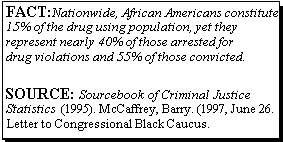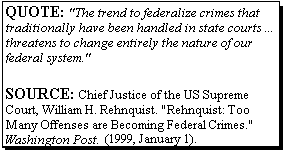
OBJECTIVE: MAKE CRIMINAL PENALTIES FIT THE SEVERITY OF THE CRIME
 Rationale:
The Sentencing Reform Act of
1984
Rationale:
The Sentencing Reform Act of
1984
The combination of stringent guidelines and mandatory sentencing along with similar harsh sentencing penalties adopted by most states has produced a burgeoning rate of incarceration in the United States. Prisons should be a solution of last resort. Addiction is a disease, and no disease, whether it is cancer or addiction, is effectively treated by incarceration. Moreover, our nation's addiction to prison building has contributed to declines in education spending in many states and undermines the global competitiveness of our country.
Recommendation 1: End mandatory minimum sentencing (statutory and guideline).
70Although few anticipated the outcome when these laws were being drafted, mandatory minimum sentencing has had an extremely negative impact on American society and has failed to meet its objectives. It is time to restore the traditional authority of judges to determine sentences on a case-by-case basis, so that punishments fit the crime. Consider the following facts:
Combined, these facts tell us that mandatory minimum sentencing has forced us to build many new prisons to house low-level and non-violent offenders for extremely long periods of time. According to the Federal Bureau of Prisons, the sentence for the average drug offender is 2.5 times that of the average assault sentence. Ironically, even building new prisons to hold drug offenders for an average of 82.3 months does not provide enough prison space because new prisons are being built all the time. Considering the fact that 24 million Americans used illegal drugs in the past year, it is hard to see how increased incarceration has done anything to stop drug use in America.75 Moreover, the Department of Justice has acknowledged that, “the amount of time inmates serve in prison does not increase or decrease the likelihood of recidivism.”76
Unfortunately, mandatory minimum sentencing has been largely a failure at apprehending and
holding high-level drug
dealers.77
By removing a judge's discretion from considering the actions
of a drug defendant during the sentencing phase of a case, prosecutors have been handed
incredible power.
 By deciding how much of a drug to charge to a particular defendant, prosecutors can essentially
determine what their sentence will
be.78
Since prosecutors are empowered to reduce sentences for
“cooperation,” high level dealers with information to trade receive reduced
sentences, while low-level participants with no information to trade often receive the
harshest penalties. Another problem with the prosecutors power to force witnesses to cooperate
is the expansion of false
testimony79 in
drug cases and the abuse of conspiracy laws –
which allow lengthy mandatory sentences based on the testimony of one witness who claims the
defendant was part of a drug
conspiracy.80 Clearly
such a system which gives leniency to major
drug dealers and gives low level offenders longer terms than more culpable parties must be
eliminated immediately. Some senior Federal judges have refused to take drug cases because
they do not want to be part of a process which they feel is unjust. Restoring the power to
punish to judges will restore integrity to the system.
By deciding how much of a drug to charge to a particular defendant, prosecutors can essentially
determine what their sentence will
be.78
Since prosecutors are empowered to reduce sentences for
“cooperation,” high level dealers with information to trade receive reduced
sentences, while low-level participants with no information to trade often receive the
harshest penalties. Another problem with the prosecutors power to force witnesses to cooperate
is the expansion of false
testimony79 in
drug cases and the abuse of conspiracy laws –
which allow lengthy mandatory sentences based on the testimony of one witness who claims the
defendant was part of a drug
conspiracy.80 Clearly
such a system which gives leniency to major
drug dealers and gives low level offenders longer terms than more culpable parties must be
eliminated immediately. Some senior Federal judges have refused to take drug cases because
they do not want to be part of a process which they feel is unjust. Restoring the power to
punish to judges will restore integrity to the system.
Recommendation 2: Alter sentencing guidelines so judges have more room to maneuver within Guideline boxes and make the Guidelines advisory, rather than mandatory. Guidelines should also encourage greater reliance on role in the offense as a factor that mitigates or aggravates a sentence.
As a result of mandatory sentencing guidelines, judges have too little discretion. By implementing the above recommendation, judges will benefit from the guidance of knowing what is expected in an ordinary case, but they will not be confined too tightly in unusual cases. Reducing the stakes of the calculation will also relieve other problems like 'charge bargaining' and congested appeals because more appropriate sentences will be passed. If our legal system can distinguish between different types of homicide defendants, then at the very least, drug defendants should be accorded the same consideration.
Recommendation 3: Allow judges to determine whether a drug prosecution is handled more appropriately by state, local or federal courts.
 The federal government has developed a national criminal code that results in many cases
being handled by federal courts which should be handled by local courts. With regard to drug
prosecution, the power of federal prosecutors has been so greatly increased that prosecutors
play a larger role in administering justice than judges in drug
cases.81 Federal
judges can be
given some control over justice in drug cases by giving them the authority to issue a pretrial
ruling that allows them to remand a case to the local courts. Judges can weigh whether the
offenses charged are more locally based, whether local courts are better able to evaluate the
circumstances of an individual defendant or whether a local drug court (which do not exist in
the federal courts) would more appropriate for the offender. As an alternative, the Department
of Justice could develop guidelines which reduce the number of inappropriate prosecutions they
undertake.
The federal government has developed a national criminal code that results in many cases
being handled by federal courts which should be handled by local courts. With regard to drug
prosecution, the power of federal prosecutors has been so greatly increased that prosecutors
play a larger role in administering justice than judges in drug
cases.81 Federal
judges can be
given some control over justice in drug cases by giving them the authority to issue a pretrial
ruling that allows them to remand a case to the local courts. Judges can weigh whether the
offenses charged are more locally based, whether local courts are better able to evaluate the
circumstances of an individual defendant or whether a local drug court (which do not exist in
the federal courts) would more appropriate for the offender. As an alternative, the Department
of Justice could develop guidelines which reduce the number of inappropriate prosecutions they
undertake.
Recommendation 4: Cease the costly and ineffective targeting of marijuana possession cases.
The most recent FBI Uniform Crime Reports indicate that there were 695,201 marijuana arrests in 1997, which is about a 100% increase since 1991. Eighty-seven percent (87%) of these arrests were simply for possession of marijuana. Since the vast majority of arrests are for possession, there is clear evidence that these cases consume a disproportionate share of law enforcement resources that could otherwise be devoted to fighting property and violent crimes. According to the same FBI data, nearly as many people were arrested for marijuana offenses as were arrested for murder, rape, robbery, and aggravated assault combined.
 In the November 1998 elections, Arizona and Oregon voters registered their support for
fundamental change in our approach to drug policy by: 1) rejecting a measure to recriminalize
marijuana possession (67% of voters in Oregon opposed making marijuana possession a criminal
offense); 2) enacting a ballot initiative that removes criminal penalties for possession of
any drug and substituting treatment in its place (51.7% of voters in Arizona opposed using
incarceration even for repeat offenders of any drug offense). The FBI data indicate that small
possession cases receive too much law enforcement resources and there is growing evidence of
voter disenchantment with those policies. Therefore, law enforcement agencies should cease the
costly and ineffective practice of targeting possession cases and local governments ought to
develop alternatives to arrest, prosecution and incarceration of people who possess small
quantities of drugs.
In the November 1998 elections, Arizona and Oregon voters registered their support for
fundamental change in our approach to drug policy by: 1) rejecting a measure to recriminalize
marijuana possession (67% of voters in Oregon opposed making marijuana possession a criminal
offense); 2) enacting a ballot initiative that removes criminal penalties for possession of
any drug and substituting treatment in its place (51.7% of voters in Arizona opposed using
incarceration even for repeat offenders of any drug offense). The FBI data indicate that small
possession cases receive too much law enforcement resources and there is growing evidence of
voter disenchantment with those policies. Therefore, law enforcement agencies should cease the
costly and ineffective practice of targeting possession cases and local governments ought to
develop alternatives to arrest, prosecution and incarceration of people who possess small
quantities of drugs.
68 The Comprehensive Crime Control Act of 1984. (1984). Pub. L. No.
98-473, 8 Stat. 1937.
69 The 1986 Anti-Drug Abuse Act, Pub. L. No. 570. (1986). 9th Congress
2nd Session.
70 H.R. 957, The Sentencing Uniformity Act was introduced by
Rep. Edwards (D-CA) and 36 cosponsors on Feb. 17th 1993, which would have
repealed all federal mandatory minimum sentences. On April 8th, 1997, Rep.
Barney Frank (D-MA) introduced H.R. 1237, a bill to Exempt Some Non-violent
Drug Offenders from Mandatory Minimum Sentences.
71 Currie, E. Crime and Punishment in America. (1998). Holt
Metropolitan Publishers.
72 Bureau of Justice Statistics. (1997) BJS Sourcebook, 20.
Washington DC: US Government Printing Office.
73 Bureau of Justice Statistics, US Department of Justice.
Sourcebook of Criminal Justice Statistics, 1994. (Estimate as
$25,000/inmate).
74 US Sentencing Commission. (1995, February). Special Report to
Congress: Cocaine and Federal Sentencing Policy, Table, 18. Washington, DC:
U.S. Sentencing Commission, pg. 170.
75 NIDA. National Household Survey on Drug Abuse: Population
Estimates 1997. (1998). SAHMSA, p. 17.
76 US Department of Justice. An Analysis of Non-Violent Drug
Offenders with Minimal Criminal Histories. (1994, February). Washington,
DC: U.S. Department of Justice.
77 A survey by the US Sentencing Commission found that only 11% of
federal drug defendants were considered high level dealers. US Sentencing
Commission. (1995, February). Special Report to Congress: Cocaine and
Federal Sentencing Policy, Table, 18. Washington, DC: U.S. Sentencing
Commission, pg. 170.
78 Caulkins, J., et.al. (1997) Mandatory Minimum Drug Sentences:
Throwing Away the Key or the Taxpayers Money?, 16. Santa Monica, CA: RAND
Corporation.
79 False testimony has become so common in drug cases that it is now
known as "testilying" Eric E. Sterling, "Perpspective on Perjury: Lying is the
American Way," Los Angles Times, Januay, 12, 1999.
80 See, 21 USC Sec. 846; "Snitches," Frontline, PBS, January 26, 1999;
Cynthia Cotts, "Rat Pack," The Village Voice, January 6, 1999.
81 For an in depth analysis of the undue power of federal prosecutors,
please see the Pittsburgh Post-Gazette series, "Win At All Costs:
Government Misconduct in the Name of Expedient Justice," (November 1998) by
Bill Moushey.